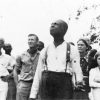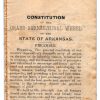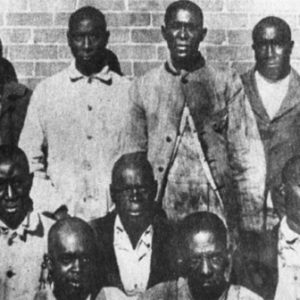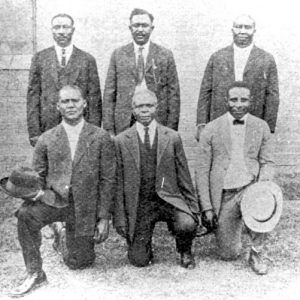calsfoundation@cals.org
Ed “Sweat” Coleman (1855–1928)
Ed Coleman was one of twelve African-American men accused of murder and sentenced to death following the Elaine Massacre of 1919; he was part of the U.S. Supreme Court case of Moore v. Dempsey. After brief trials, the so-called Elaine Twelve—six who became known as the Moore defendants and six who became known as the Ware defendants—were found guilty of murder and sentenced to death. Ultimately, the Ware defendants were freed by the Arkansas Supreme Court in 1923; after numerous legal efforts, the Moore defendants, including Coleman, were released in 1925.
Little is known about Ed Coleman’s early life. He was born in Arkansas around 1855, likely in slavery, to Robert Coleman and Jane Kelley. Coleman next shows up in the historical record in the early twentieth century working twelve acres of cotton and six acres of corn in Elaine (Phillips County), where he lived with his wife, whose name is unknown.
On September 30, 1919, sharecroppers from Phillips County who had joined the Progressive Farmers and Household Union of America were holding a meeting at the church in Hoop Spur, just north of Elaine, to discuss fair wages. Coleman, however, was not present; he later asserted that he was asleep at home, two and a half miles away, when the shooting at the church began. The next morning, he saw an estimated 200–300 armed white men moving through the surrounding fields. Coleman and others attempted to escape to the railroad but were cut off. After being fired upon, someone in Coleman’s group returned two shots (neither a killing shot) before running back into the woods nearby. The following day, Coleman returned to his home to retrieve his wife, only to be told that women and children had begun to be targeted in the violence. Coleman discovered his wife near death and carried her out into the woods to hide. She later died, and her burial place is unknown.
On October 31, a total of 122 black men were indicted by the Phillips County Grand Jury for their part in the riots. Judge J. M. Jackson began the trials on November 3. On this day, the six Moore defendants—Frank Moore, Frank and Ed Hicks, Joe Knox, Paul Hall, and Coleman—were all tried for the murder of Clinton Lee. Frank Hicks was tried first, as he had been accused of shooting Lee, although one white witness, Tom Faulkner, could not identify Hicks as the shooter. According to newspaper reports, the jury took just eight minutes to deliberate over Hicks’s trial before finding him guilty of murder. The remaining five men, including Coleman, were tried together as accessories to murder and found guilty. All six were sentenced to death, as were the six defendants in the separate Ware case.
The cases drew the attention of the National Association for the Advancement of Colored People (NAACP), which galvanized support for the defendants and raised money for their legal counsel. It was in the defense of the Elaine Twelve that African-American attorney Scipio Jones rose to national acclaim. After a series of legal maneuvers and appeals, on February 19, 1923, the U.S. Supreme Court handed down its 6–2 decision in favor of the Moore defendants. The justices held that, considering that the original trials had been mob dominated, the “corrective process afforded to the petitioners…does not seem sufficient,” and in such circumstances, federal judges had jurisdiction to overturn state criminal verdicts to rectify judicial failures of the state and to ensure that the defendants were granted due process.
Despite a favorable ruling from the U.S. Supreme Court, the case was not over; indeed, the Court had called for a re-hearing in the district court. The Moore defendants were still in jail and could have faced a re-trial. However, Jones moved to evade any more trials and have the men released from jail. On November 3, 1923, Arkansas governor Thomas McRae, following a petition in Phillips County, announced that he had commuted the death sentences to twelve years in prison, making the men eligible for parole, as they had served a third of that time. It was not until January 14, 1925, however, that the six Moore defendants were finally freed from jail, having been granted indefinite furloughs from McRae the day before. (The Ware defendants had been released in 1923.) After his release, Coleman moved to Memphis, Tennessee, where he found employment as a laborer.
On January 16, 1928, Coleman died of uremia and hypertrophy of the prostate after twenty-two days in the hospital. His body was transported to Arkansas, and he was buried in Herbert (Ouachita County) on January 22, 1928.
For additional information:
Cortner, Richard C. A Mob Intent on Death: The NAACP and the Arkansas Riot Cases. Middletown, CT: Wesleyan University Press, 1988.
Pruden, William H. III. “Cracking Open the Door: Moore v. Dempsey and the Fight for Justice.” In The Elaine Massacre and Arkansas: A Century of Atrocity and Resistance, 1819–1919, edited by Guy Lancaster. Little Rock: Butler Center Books, 2018.
Stockley, Grif, Brian K. Mitchell, and Guy Lancaster. Blood in Their Eyes: The Elaine Massacre of 1919. Rev. ed. Fayetteville: University of Arkansas Press, 2020.
Wells, Ida B. “The Arkansas Race Riot.” Online at https://archive.org/details/TheArkansasRaceRiot/page/n1 (accessed March 30, 2020).
Whayne, Jeannie M. “Low Villains and Wickedness in High Places: Race and Class in the Elaine Riots.” Arkansas Historical Quarterly 58 (Autumn 1999): 285–313.
Whitaker, Robert. On the Laps of Gods: The Red Summer of 1919 and the Struggle for Justice that Remade a Nation. New York: Crown, 2008.
Brian K. Mitchell, Kathryn M. Bryles, Andrew A. Mcclain, Jessica Parker
University of Arkansas at Little Rock
 Civil Rights and Social Change
Civil Rights and Social Change Early Twentieth Century, 1901 through 1940
Early Twentieth Century, 1901 through 1940 Labor Movement
Labor Movement Elaine Massacre Defendants
Elaine Massacre Defendants  Elaine Massacre Defendants
Elaine Massacre Defendants 



Comments
No comments on this entry yet.